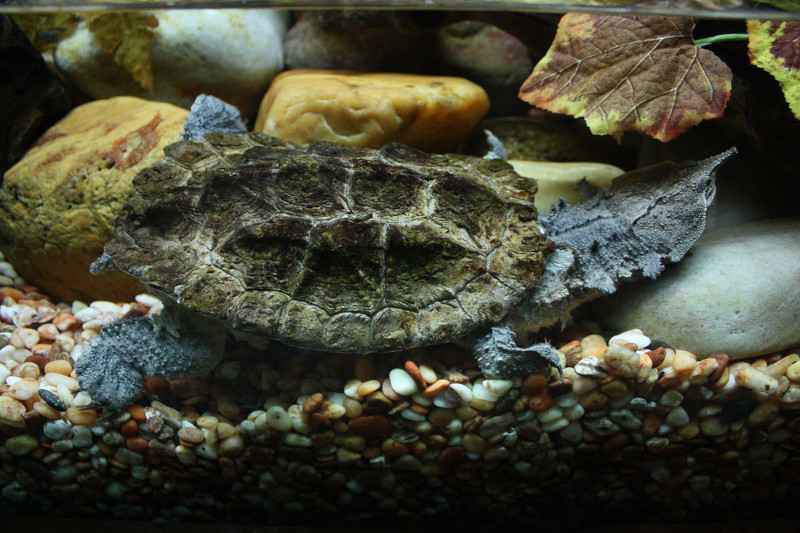
Mata mata Facts
- The highly unique term of Mata mata actually represents the most frequently employed common name for this extraordinary creation of Nature. Yet, it does possess several other general titles by which it’s known. These include the terms Fringe-heaed turtle and matamata.
- Within the scientific community, though, it’s perhaps much better known by its entirely technical designation. Thankfully, that’s an extremely easy one for the layperson to pronounce, at least compared to most such monikers. It holds the formal tag of Chelus fimbriata.
- Regardless of the name you choose to use to refer to the animal, the term always refers to a highly distinctive species of freshwater turtle. In point of fact, it’s renowned for its extremely unique appearance. This prompts some people to refer to the animal as a living fossil.
- The first official scientific recognition of this remarkable creature took place in the year 1741. At that time, the renowned French naturalist Pierre Barrere described the creature, but did not designate a name for it. Quite surprisingly, it has been renamed more than a dozen times.
- The amazing reptile also stands out for another reason. Unlike many species still existing today, its population numbers appear to still be sufficient and relatively stable. As a result, the IUCN currently lists the Mata mata as Least Concern on its Red List of Threatened Species.
- Given its particular habitat range, however, the work of evolution must be considered to be at least potentially at risk in the future. One of the multiple factors to be considered remains that of possible habitat loss. Its greatest threat, though, will likely come from climate change.
Related Articles
Mata mata Physical Description
Although the astounding Mata mata garners fully merited appreciation by those individuals meeting it, the turtle does not do so based on physical size. In those terms, the reptile only qualifies as roughly an average-sized variety of turtle. It’s in other manners that this turtle stands out.
In terms of its physical dimensions, the carapace of a fully mature adult specimen averages about 18 in (45 cm) in length. Its weight, meanwhile, averages approximately 33 lb (15 kg) for the same mature adult individuals. The truly distinctive characteristics, though, actually appear in other areas.
The Mata mata also displays a very slight degree of the physiological trait of sexual dimorphism. In its particular case, though, this trait manifests itself in the appearance of the tail of the animal. Specifically, that of the adult male develops as somewhat thicker in shape than that of the female.
Otherwise, the genders remain virtually indistinguishable to the observer. Its most notable characteristic, however, unquestionably remains its remarkable shell. This develops with an oblong shape, and a covering of sharp ridges. The reason for this eludes scientists studying the animal.
It also develops a relatively large, and, incredibly, a markedly strongly flattened head, possessing a small horn on its snout. The carapace itself also typically displays either a dark brown or black color. The neck, tail, head, and limbs, though, most commonly display a slightly grayish brown shade.
- Kingdom: Animalia
- Phylum: Chordata
- Class: Reptilia
- Order: Testudines
- Family: Chelidae
- Genus: Chelus
- Species: C. fimbriata
Mata mata Distribution, Habitat, and Ecology
The astonishing creature known to man as the Mata mata inhabits a relatively extensive region of the surface of the world. This same region also happens to be one that abounds with an astounding variety and abundance of life. It evolved as endemic to specific portions of South America.
Not surprisingly, though, the astounding animal primarily appears in the expansive Amazon and Orinico Basins. This provides it with an enormous volume of space in which to make its home. Even there, though, the truly remarkable turtle has very specific requirements for its choice of habitat.
This creature demonstrably prefers to live in areas comprised of relatively slow-moving, blackwater streams. It will also, though, appear in other, similar environments. These most commonly include such areas as marshes, larger stagnant pools, and even occasionally certain swampy areas.
Being primarily an aquatic species in nature, it spends the great majority of its time submerged in water, typically with only its snout extending. This highly skilled hunter snaps its powerful jaws closed on any hapless small fish or invertebrate that ventures to close, then swallowing it whole.
In its indigenous region, the mighty Mata mata usually nests between October and December, after mating. The female typically lays between 12 – 28 delicate, spherical-shaped eggs. These she deposits in the nest constructed by, and watched over by, both parents until hatching occurs.
Species Sharing Its Range
Check out our other articles on 4 Beguiling Bats, Black-and-white hawk-eagle, Namib Desert, Muhure, Harbor Porpoise, Saint Francis’ Satyr Butterfly, Wallace’s Flying Frog, Green Iguana
